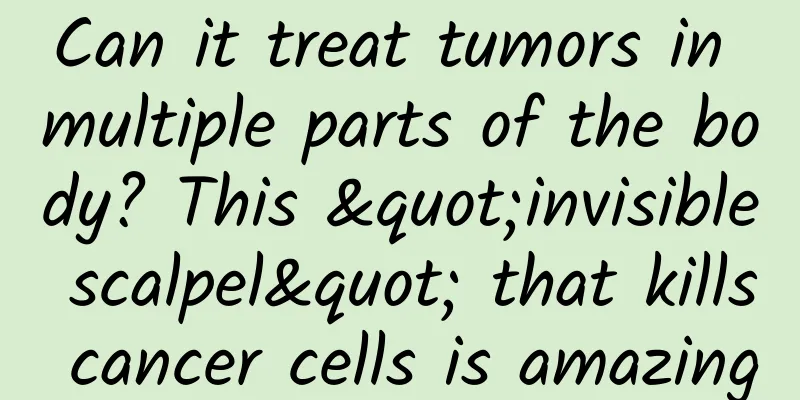Can it treat tumors in multiple parts of the body? This "invisible scalpel" that kills cancer cells is amazing

|
Radiotherapy as a treatment for tumors It has a history of more than 100 years It has been proven to be an effective treatment However, many cancer patients and their families still have some doubts Today we will take a deep dive into tumor radiotherapy Dispel everyone's doubts Radiotherapy is a treatment method that uses high-energy rays to kill or inhibit the growth of cancer cells. It can be used at all stages of cancer treatment, and about 70% of cancer patients need radiotherapy. Image source: Photo Network However, when it comes to radiotherapy, many people still feel hesitant. After radiotherapy, the whole body is exposed to radiation. Will the tumor be cured, but the person will gradually become useless? Your impression of radiotherapy is still "using a cannon to kill a mosquito", which is really outdated! Modern radiotherapy has long entered the "precision" era, and can accurately treat local tumors while reducing damage to surrounding normal tissues . There is no need to worry about "killing one thousand enemies and injuring eight hundred of your own." The invisible and intangible rays are like an " invisible scalpel " that can penetrate the human body and directly hit tumor cells. The treatment process is non-invasive and painless, with little impact on the whole body and low risks of bleeding and infection. Image source: Photo Network Of course, the side effects of radiotherapy that people are most worried about, such as fatigue and skin reactions, do exist, but don't panic! With the advancement of technology, these side effects have been better controlled and managed, which can improve the treatment effect while minimizing the side effects. Radiotherapy can be used not only alone, but also in combination with other treatments such as surgery and chemotherapy. It is suitable for the treatment of a variety of tumors, such as: Head and Neck Cancer Nasopharyngeal cancer image source: Photo Network These include nasopharyngeal cancer, laryngeal cancer, oral cancer, etc. These tumors are usually located in the head or neck. Due to the complex structure of these areas, surgery may be difficult or risky, and radiotherapy can provide a relatively non-invasive treatment option. Chest tumors Esophageal cancer Image source: Photo Network Such as lung cancer, esophageal cancer and breast cancer. These tumors can be treated with radiation therapy to slow disease progression or control symptoms in the early or advanced stages. Abdominal and pelvic tumors Colorectal cancer Image source: Photo Network For example, for some patients with rectal cancer, preoperative radiotherapy can help shrink the tumor and improve the success rate of surgery. Rectal cancer patients can also use radiotherapy as postoperative adjuvant treatment to reduce the risk of postoperative recurrence. Urinary system tumors Prostate cancer image source: Photo Network For example, for prostate cancer, one of the most common cancers in men, radiation therapy can be used alone, especially in the early stages of the disease, or in combination with hormone therapy. Gynecological tumors Cervical cancer image source: Photo Network Including cervical cancer, endometrial cancer, etc. Radiotherapy is very important in the treatment of gynecological tumors. Postoperative adjuvant radiotherapy can significantly reduce the risk of recurrence. For inoperable cervical cancer, external radiotherapy and intracavitary afterloading radiotherapy, combined with chemotherapy can be used as radical treatment. The entire process of radiotherapy is very complex and delicate, with each step closely linked to the next. Image source: Photo Network 1 Determination of treatment strategy The doctor will make a comprehensive evaluation based on the patient's medical history, physical examination results, pathological diagnosis, X-rays, CT/MRI/PET examination results, B-ultrasound examination results and SPECT examination results to determine the patient's general condition, disease stage, pathological type, tumor location, tumor range, etc., and formulate a treatment strategy accordingly. 2 Treatment goals and radiotherapy methods are determined Based on the treatment strategy determined above, the doctor will determine the purpose of radiotherapy (such as radical radiotherapy, palliative radiotherapy, etc.) and the method of radiotherapy (such as external radiotherapy, intracavitary radiotherapy, interstitial radiotherapy, etc.). In addition, the method of radiotherapy fractionation will also be determined (such as conventional fractionated radiotherapy, hyperfractionated radiotherapy, stereotactic radiotherapy, etc.). 3 Determination of body position fixation and positioning method Each patient has his or her own "personalized" mold, which is used to fix the patient's position and ensure that the patient's position is consistent during each treatment. The doctor will choose a suitable mold for the patient based on the location of the lesion, such as a head mask for patients undergoing brain radiotherapy, and a head, neck and shoulder mask for patients with lesions in the neck and upper chest. Positioning methods may include simulator positioning, CT simulator (CT-SIM) positioning, MRI positioning, PET-CT positioning, etc., depending on the specific selection of radiotherapy methods and implementation approaches . 4 Treatment planning Like an architect, the doctor will design a blueprint for treatment, determine the treatment area (target area) and the protection range of surrounding normal tissues, and develop a detailed radiotherapy plan, including field selection, dose distribution, etc. 5 Plan Verification Just like checking architectural drawings, before treatment begins, the doctor will perform a simulation to ensure that the planned projections are consistent with the patient's actual treatment. If problems are found, the cause will be investigated and replanning may be necessary. 6 Plan Execution After the plan is verified, the patient can undergo formal treatment. Each treatment will strictly maintain the same body position, and the image guidance system will be used to verify the irradiation field and irradiation target area, just like the navigation system ensures that we will not go the wrong way, once again ensuring the quality and safety of the patient's treatment. 7 Plan revision and correction During radiotherapy, the treatment plan is promptly modified and corrected based on the results of each image-guided examination of the patient, and repositioning may be required if necessary. 1. Skin care
1 Monitor blood routine A blood test is required within one week after radiotherapy to observe the white blood cell count. If the white blood cell count is normal, you can go home and rest. 2 Protect local skin Radiotherapy may cause dryness, redness, swelling, and peeling of the skin in the irradiated area. Keep the skin in the irradiated area dry and clean, avoid using strong detergents, wear loose and soft clothes, and avoid scrubbing vigorously. 3 Regular review A comprehensive review is recommended one month after the end of radiotherapy to observe the tumor shrinkage. After that, regular review may be required every 3-6 months based on the doctor's advice. 4 Oral Care Radiation therapy may cause dry mouth and damage to the oral mucosa. It is recommended to rinse your mouth and brush your teeth regularly, use mild oral care products, and increase your water intake. 5 Avoid infection The patient's immunity may decrease after radiotherapy, so they should try to avoid contact with environments containing pathogens, pay attention to personal hygiene, and wash their hands frequently. 6 Rest and Activities Although it is a recovery period, you should still avoid excessive fatigue. Appropriate light exercise, such as walking and yoga, can help your body recover. 7 Take medicine on time Take medications strictly according to your doctor's instructions, including chemotherapy drugs and supportive drugs, and pay attention to possible side effects of the drugs. 8 Dietary modification Maintain a balanced diet, increase protein and vitamin intake, and avoid spicy and irritating foods. come on Let’s win the battle against cancer together! Statement: This article is a medical-related educational popular science article. It does not involve specific treatment methods or medical behaviors and cannot replace hospital visits. Experts collaborating on this article Content Production Edit: 100% sweet Map: Eastern Zhou Dynasty |
>>: When there is a traffic jam, what is the first car doing?
Recommend
Tesla still stubbornly insists on the visual route. Will LiDAR have the last laugh?
Recently, Musk showed off his strength at Tesla&#...
Why does time seem to pass slowly when we are doing homework, but pass quickly when we are playing?
Why does time seem to pass slowly when we are doi...
Top 10 Core Data tools and open source libraries loved by developers
Core Data is a great choice for storing and query...
Smali disassembly language data types and methods
Introduction to Smali Smali is a disassembly lang...
Beware! If you see these bugs recently, don’t take photos!
This article was reviewed by Zhang Qikai, Chinese...
Community operation management, growth and sustainable core
I think whether a group is well managed or not de...
As the "superior" in evolution, why do humans need to supplement vitamin C?
Eagles fly in the sky, fish swim in the shallows,...
How is the random algorithm of WeChat red envelopes implemented?
I saw a question on Zhihu: How is the random algo...
What should you do to stay safe when you encounter wild animals?
Mixed Knowledge Specially designed to cure confus...
How to optimize the account when Baidu bidding promotion is not effective?
How to optimize the account when Baidu bidding pr...
Xiaohongshu promotion and marketing guide, teach you to avoid 90% of the pitfalls
Facing the precise 200 million young female user ...
Are the “edited” vegetables delicious?
The cover image is a copyrighted image. Reprintin...
Misconception! 5 common misunderstandings about information flow advertising image materials, with 4 guidelines + 2 cases attached!
Introduction: This article lists five major color...
Flex your fingers every day and take home the Nobel Prize
There is a way to show off your power at the lowe...









